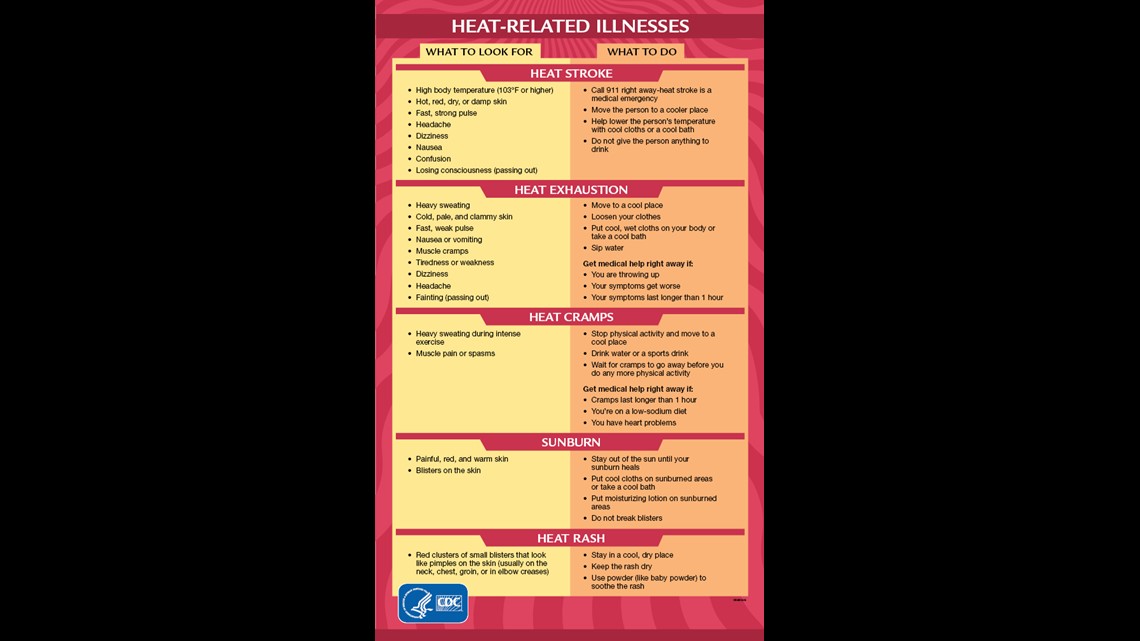SACRAMENTO, Calif. — The Sacramento area will be in for some scorching hot days as temperatures venture into triple digits.
As the temperature increases, chances for heatstroke and heat stress also increase. There are a number of opportunities to beat the heat during a heat wave, which range from water parks to air-conditioning. But it’s also important to be aware of what should be done to protect yourself, your belongings, and those who depend on you.
These efforts can mean the difference from damages to property and devastating heat-related illness to people and pets.
Here are five tips to live by in a California heat wave:
1. Be aware of the heat advisory
A heat advisory has been issued for Northern California as parts of the Central Valley and the foothills may experience temperatures from 100 degrees to 108 degrees. According to the National Weather Service (NWS), this kind of heat only comes about a few times each year.
Central Valley highs will range between 105 to 110° and overnight lows will also be warm, only cooling to the 60s to mid-70s.
An Excessive Heat Warning is in effect Monday and Tuesday due to these hot afternoon temperatures and warm overnight lows. The peak heat during the day hits between 4 p.m. to 6 pm.
2. Take efforts to cool yourself
When the body is not able to properly cool itself, it’s possible to experience a heat-related illness like heat exhaustion or heatstroke, according to the Center for Disease Control (CDC). This occurs when the body’s temperature is rising faster than it can cool itself down. Older adults, the very young, and people with mental illness chronic diseases were noted by the CDC as being some of the most at-risk individuals. However, even people who are young and healthy could be affected if they engage in strenuous activities in hot weather.
The CDC advises people to stay in an air-conditioned place when there are extreme heat conditions. They add that electric fans will not prevent heat-related illness when temperatures are in the high 90’s. Instead, the CDC suggests taking a cool shower, bath, or moving to an air-conditioned place to cool off.
If heading outdoors is inevitable, it is suggested that people protect themselves from the sun with wide-brimmed hats, sunglasses, and applying an SPF 15 or higher sunscreen 30 minutes before going out.


3. Inspect your car for damages and wax it to prevent damage
According to Cars.com, the summer heat can also put stress on cars. It recommends checking rubber items like radiator hoses and belts for cracking or degradation that might come about from the heat. Waxing as way to prevent the sun’s rays from damaging the paint and checking the air conditioner for a refrigerant recharge were also ways that were identified to protect cars in the heat.
4. Remember to take care of your pets
As the temperature increases, people aren’t the only ones impacted. Pets can be impacted by the heat as well, which is especially true for young, elderly, or overweight animals. This includes animals with pets with thick or dark-colored coats and animals with short muzzles or flat faces like Pugs or Persian cats. According to the American Society for the Prevention of Cruelty to Animals, these animals can be more susceptible to heatstroke since they cannot pant effectively.
Pets should not be left alone in a car. According to the ASPCA, there are state and local governments, including California, that prohibit leaving animals unattended in cars under dangerous conditions, which includes hot days. Temperatures in vehicles can quickly rise to dangerous levels and potential heat related illnesses.
Even walking a dog should be treated with caution during hot days. According to the Humane Society of the United States, asphalt can get hot enough to burn a pet’s paw. A simple test is to place the back of your hand on the asphalt. If the asphalt is too hot for you, then it is too hot for the pet.
5. Do not leave children unattended in hot vehicles
Do not leave children in cars. The California Officer of Traffic Safety advises to never leave a child alone in a car, “not even for a minute.” Interior temperatures of a car can easily reach 140 degrees on a 101 degree day.
According to the CDC, children are especially at risk of getting heatstroke or dying when left in a parked car. They advise that infants should never be left alone in the vehicle, even if the window is cracked open.
In 2017, the National Highway Traffic Safety Administration identified heatstroke as the leading cause of non-crash related vehicle fatalities for kids 14 years and younger in the United States. Jan Null, a meteorologist and adjunct professor in the Department of Meteorology & Climate Science at San Jose State University, gathered statistics on heatstroke deaths of children in vehicles through online news searches of electronic media like Google News and Lexis-Nexus. His data, which is also used by the National Safety Council, revealed 45 pediatric vehicular heatstroke deaths in California from 1998 to 2017.
If a child is seen unattended in a hot vehicle, 911 should be called, according to the California Office of Traffic Safety. EMS professionals are trained to determine if a child is in trouble. When leaving the car, it is advised that a check is done to ensure everyone is out of the car.
WATCH MORE ABC10: Tips to stay cool with the excessive heat warning in Northern California
Whether you're heading outdoors or staying inside, there are a couple of things you can do to beat the heat.

